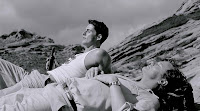 Sometimes, the language of film, and the language of literature, just fit together like a puzzle. When I think of great directors and great writers with similar visions, I usually just think of the Coen Brothers and Cormac McCarthy over “No Country for Old Men.” Now, I can add Martin Scorsese and Dennis Lehane, over “Shutter Island.”
Sometimes, the language of film, and the language of literature, just fit together like a puzzle. When I think of great directors and great writers with similar visions, I usually just think of the Coen Brothers and Cormac McCarthy over “No Country for Old Men.” Now, I can add Martin Scorsese and Dennis Lehane, over “Shutter Island.”
In novel form, “Shutter Island” was a crackling and suspenseful psychological mystery that never took the obvious route. As a film, it is both a psychological thriller and an ode to a genre that seemed to have died ages ago. “Shutter Island” is set in the year 1954. Miles off the coast of Boston, there is a place called Shutter Island. It houses a mental institution for the criminally insane. The most dangerous patient, Rachel Salondo, has somehow escaped. U.S. Marshall Teddy Daniels (Leonardo DiCaprio) and his partner Chuck Aule (Mark Ruffalo) have been assigned to crack the case.
Before going on there are a few character points, rather than plot points, that need to be explained. Teddy is a war hero, haunted by what he saw when liberating Dachau. His wife (Michelle Williams) recently died in a fire. So yeah, this guy has problems. Meanwhile, Salondo murdered her children.
Over the years, Scorsese’s directorial skill has been put into question. Yes, he’s made a few flawed pictures (“Gangs of New York,” “The Aviator”), but even those are more watchable than most of the films that come out today. Truth is, most of his recent stories do not even come close to his old ones. However, could anyone ever make a film as good as “Taxi Driver” or “Raging Bull” ever again?
“Shutter Island” clicked for me because I feel it has something for everyone: a little bit of entertainment and a little bit of depth. It’s the kind of film that you walk out of wanting to talk to someone about the ending. It’s also the kind of film where you know, in the end, your money has been well spent.
“Shutter Island” shows that Scorsese, more than ever, knows how to work a camera. Not only that, but turn it into a form of art. Here, he brings back the long shots he used so masterfully in “Goodfellas” and does a few other camera techniques that bring out the ever growing sense of chaos.
This also shows how Scorsese is one of those rare directors who make movies with the self-awareness of being a movie, and being so inspired by movies of the past. The dark, smoke-filmed rooms totally bring out the film noir of the 1940s and 50s. I originally thought the music was somewhat overdramatic but when I think about it, I think it is meant to evoke the somewhat over-the-top nature of old thrillers.
Also, there is a very poor green screen in the backgrounds of some shots. It may evoke the Golden Days of Hollywood. However, it may also evoke some things about the character which I will not spoil for you. But only a director like Scorsese could use something so faulty and make them inspired and ironic.
Along with Scorsese’s direction, the acting was also fantastic. DiCaprio is truly proving himself to be a great leading man now. He corresponds well with Scorsese’s direction by constantly bringing out the trembling darkness within Teddy.
Also scoring a great performance by Ben Kingsley as the head doctor. I think it’s his line delivery that did it for me. The way he says, “it’s like she evaporated, straight through the walls,” is one that sounds both entirely innocent and oddly disturbing.
Back to Scorsese for a minute, because he is truly what makes this movie for a work. I want to use one specific scene to show his great direction. In one scene, Teddy is climbing down a steep, rocky cliff. We know the hero can’t die this early, but Scorsese puts a big, fat question mark to that possibility. He shoots this scene from very tight, claustrophobic angles and we feel like we’re there with him, climbing down those rocks. He takes a scene that might have made the viewer feel nothing, and packs it with suspense.
I believe the story goes from page to screen so well because Scorsese takes Lehane’s story and themes and makes them into his own style. Through the characters of Teddy and Rachel Solando, Lehane finds characters searching for redemption and trying to come to terms with their pasts, and their selves. Teddy’s own struggle with the horrors of war he’s seen could mirror what Travis Bickle had to live with in “Taxi Driver.” Through this, we can understand the character of “Shutter Island” even better.
The story of the film of “Shutter Island” isn’t much different than it was in the book. However, the fact that Scorsese can take Lehane’s style and mold it into his own is what makes this a truly faithful, truly successful adaptation. Scorsese takes Lehane’s dark message about human nature, and turns it into a haunting (and even relevant) message about how today’s world works.
Of course, there is quite a surprise of an ending. Even for somebody who read the book and knew the ending, I was still surprised when the big moment came. Scorsese masterfully knew how to both hide the truth and even make it seem very apparent at other times.
The more I think about “Shutter Island,” the more I like it. Scorsese has truly made a movie for everyone: it’s both simply entertaining, and complexly thought provoking. Quite simply, it is the ultimate experience for those who love movies.
 Sometimes, the language of film, and the language of literature, just fit together like a puzzle. When I think of great directors and great writers with similar visions, I usually just think of the Coen Brothers and Cormac McCarthy over “No Country for Old Men.” Now, I can add Martin Scorsese and Dennis Lehane, over “Shutter Island.”
Sometimes, the language of film, and the language of literature, just fit together like a puzzle. When I think of great directors and great writers with similar visions, I usually just think of the Coen Brothers and Cormac McCarthy over “No Country for Old Men.” Now, I can add Martin Scorsese and Dennis Lehane, over “Shutter Island.”
 Mia is always running. You would to if you lived a life like her’s. Her life is hard. That might sound vague, but her plight is emphasized in almost unbearably vivid detail in “Fish Tank.”
Mia is always running. You would to if you lived a life like her’s. Her life is hard. That might sound vague, but her plight is emphasized in almost unbearably vivid detail in “Fish Tank.”
 Of all the movies I’ve seen, even the strangest still give me something to say. It is at the rarest occasion that I am almost at a loss for words. One of these rare occasions occurred as I watched Duncan Jones’ “Moon.”
Of all the movies I’ve seen, even the strangest still give me something to say. It is at the rarest occasion that I am almost at a loss for words. One of these rare occasions occurred as I watched Duncan Jones’ “Moon.”
 The next time somebody says to you, “they don’t make ‘em like they used to,” know that they’re likely talking about “The Conversation.” Nobody observes time and space while fully exploiting all the great elements of film quite like Francis Ford Coppola did.
The next time somebody says to you, “they don’t make ‘em like they used to,” know that they’re likely talking about “The Conversation.” Nobody observes time and space while fully exploiting all the great elements of film quite like Francis Ford Coppola did.
 I spend a lot of time on this blog talking about Quentin Tarantino. And over the past few posts, I’ve mentioned “Inglourious Basterds” at least once. You’re probably so sick of the name by now. However, this is one piece of news you just may have to hear.
I spend a lot of time on this blog talking about Quentin Tarantino. And over the past few posts, I’ve mentioned “Inglourious Basterds” at least once. You’re probably so sick of the name by now. However, this is one piece of news you just may have to hear.
 Ignore the posters that make this film out to be a romance between Colin Firth and Julianne Moore. Ignore the buzz that makes this film seem like nothing more than a “gay movie.” “A Single Man” is much more than a romance of any kind. “A Single Man” is a film with amazing depth, but unfortunately, falls just short of perfection.
Ignore the posters that make this film out to be a romance between Colin Firth and Julianne Moore. Ignore the buzz that makes this film seem like nothing more than a “gay movie.” “A Single Man” is much more than a romance of any kind. “A Single Man” is a film with amazing depth, but unfortunately, falls just short of perfection.
 Melanie Laurent (Inglourious Basterds)- In a film powered by raw, unforgiving violence, Laurent was the true heart of “Basterds.” Her emotional performance as a Jew hiding in Nazi-Occupied France truly brought sympathy for this lady vengeance. By the end, when she’s become nothing but a hovering, etherial cloud of smoke, her human presence is never gone. No, it’ll live on in “Too Good for the Oscars” immortality.
Melanie Laurent (Inglourious Basterds)- In a film powered by raw, unforgiving violence, Laurent was the true heart of “Basterds.” Her emotional performance as a Jew hiding in Nazi-Occupied France truly brought sympathy for this lady vengeance. By the end, when she’s become nothing but a hovering, etherial cloud of smoke, her human presence is never gone. No, it’ll live on in “Too Good for the Oscars” immortality.




